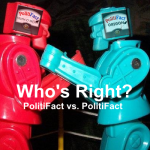On Feb. 20, 2014, PolitiFact Oregon posted a new rating relating to the gender wage gap.
PolitiFact Oregon rated it “Mostly True” that women in Oregon make 79 cents on the dollar compared to men for the same work.
It was a notable rating, since other PolitiFact ratings on the gender wage gap, while not exactly a model of consistency, have looked dimly on similar claims.
Rep. David Cicilline (D-RI) said women earn only 77 cents for every dollar earned by men in the same position. PolitiFact Rhode Island rated the claim “Mostly False.” That was on April 17, 2012.
President Barack Obama said women are paid 77 cents on the dollar for do ing the same work as men. PolitiFact rated the claim “Mostly False.” That was on June 21, 2012.
ing the same work as men. PolitiFact rated the claim “Mostly False.” That was on June 21, 2012.
PolitiFact Oregon’s case is almost perfectly parallel to the ones rated in these latter two cases. The claim rated by PolitiFact Oregon concerned data at the state level, while the other two claims dealt with national data. The key data source in each case was the U.S. Bureau of Labor Statistics.
Who’s right?
How did PolitiFact reach a “Mostly False” conclusion in two cases but a “Mostly True” conclusion in an extremely similar case? Did the data change that much?
We’ll look at the conclusion of each fact check for clues.
Cicilline
In citing the 77-cent figure, Cicilline ignores conflicting estimates suggesting that the gender gap is narrower or, perhaps, nonexistent when lifestyle choices are taken into account. He also skirts a key problem: for most occupations, there is not enough good data to make the kind of comparison he is talking about.
In other words, his statement contains some element of truth but ignores critical facts that would give a different impression: our definition of Mostly False.
PolitiFact Rhode Island also noted in its assessment that the 77-cent figure does not represent a job-to-job comparison but instead simply averages the incomes for full-time employees. We’re not quite sure what PolitiFact Rhode Island identified as its “element of truth.”
Obama
The Obama campaign took a legitimate statistic and described it in a way that makes it sound much more dramatic than it actually is. The 77-cent figure is real, but it does not factor in occupations held, hours worked or length of tenure. Describing that statistic as referring to the pay for women “doing the same work as men” earns it a rating of Mostly False.
Again, we find ourselves uncertain about what counts as the element of truth. If I say Atlanta Braves pitcher Tom Glavine threw 204 strikeouts in 1996, which isn’t true, is it “Mostly False” if it happens that Mike Mussina of the Baltimore Orioles threw 204 strikeouts, making it a “legitimate statistic”?
What makes the 77-cent figure a “legitimate statistic” for measuring the difference in pay by gender for doing the same work?
Brad Avakian
PolitiFact Oregon used five paragraphs for its summary, so we’ll summarize the material leading to their final rating.
Avakian, a Democrat running for Congress, failed to note that the 79-cent figure for Oregon applied to year-round, full-time work. He cherry-picked the 79-cent figure, since a number of other measurements produce a much lower gap. The 21-cent gap isn’t necessarily explained by gender discrimination, since the data do not ensure a job-by-job comparison. Avakian used the term “average,” but his source used the term “median.”
And the conclusion:
Those caveats aside, he still is well inside the ballpark and the ratio he cited is a credible figure from a credible agency. We rate the claim Mostly True.
Aside from the five errors PolitiFact listed, Avakian was pretty accurate. It’s a legitimate statistic, just like Tom Glavine’s Mike Mussina’s 204 strikeouts in 1996.
Seriously, for the third time in a row we just don’t see what counts as true. It’s wrong to take a statistic that fails to track the type of work done and use that statistic to claim that one group is paid less than another for the same work. It’s about as relevant to measure the gender preferences for strawberry Pop-Tarts and apply that to the gender wage gap.
Which is not to say that the difference between men’s and women’s preference for strawberry Pop-Tarts isn’t a legitimate statistic.
The real reason behind the discrepancy?
PolitiFact Oregon probably reached its out-of-step conclusion, ironically, because of a fact check by the national PolitiFact.
PolitiFact rated a statement on the gender wage gap from Obama’s 2014 State of the Union address. We published an evaluation of PolitiFact’s work on the gender wage gap on Feb. 3, 2014, criticizing it for ignoring the president’s obvious implication that the 23-cent gap exists all or mostly as a result of gender discrimination.
It is natural to take the fact check of Obama to mean that the 23-cent gap stems from gender discrimination, though one has to overlook caveats in PolitiFact’s fact check such as this one (bold emphasis added):
Ultimately, we decided that Obama’s statement that “women deserve equal pay for equal work” was aspirational rather than a part of his statistical claim, so we’re judging him on his claim that women “make 77 cents for every dollar a man earns.”
PolitiFact explicitly told its readers that the “Mostly True” rating did not apply to the implication that the wage gap was related to gender discrimination.
The writer of the PolitiFact Oregon story, Dana Tims, confirmed via email that his story relied heavily on this one, and it is the only PolitiFact story to appear on the list of sources published with his fact check.
PolitiFact misled PolitiFact Oregon. Though, to be fair, PolitiFact Oregon misread PolitiFact.
The Horns of Dilemma
Despite the difference between the “Truth-O-Meter” ratings, the rationales for each of the three fact checks run along the same lines. That creates a problem for PolitiFact, of course. Is its fact checking credible if closely parallel evaluations end up with widely different final ratings?
We’ve contacted PolitiFact Oregon and PolitiFact about the discrepancy. So far we see no move to issue a correction. Doing a correction would prove embarrassing. But not issuing a correction may prove even more embarrassing.



